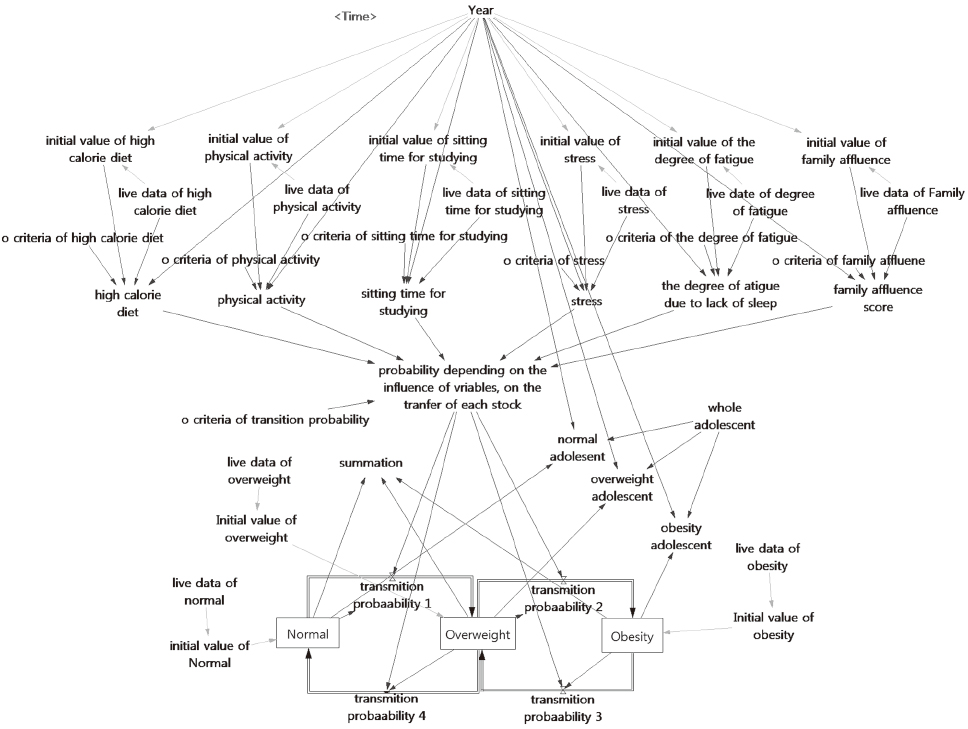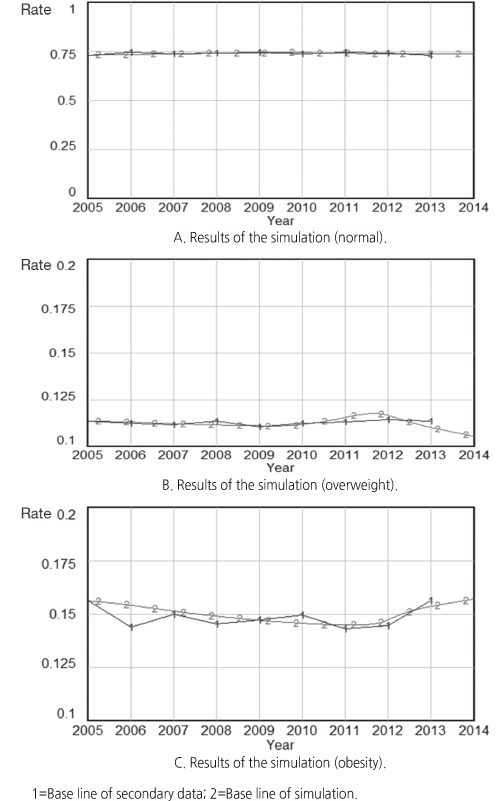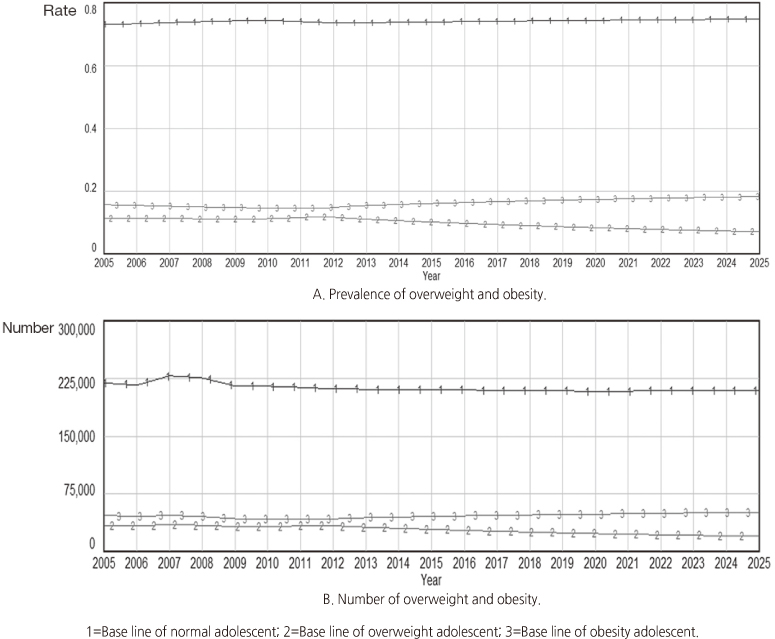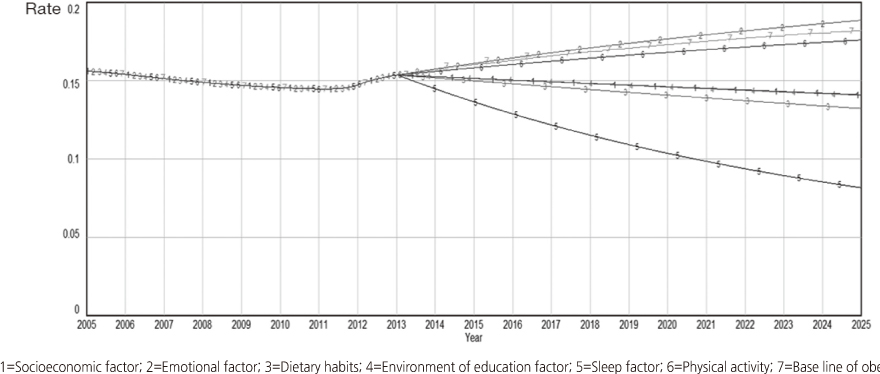Articles
- Page Path
- HOME > J Korean Acad Nurs > Volume 45(5); 2015 > Article
-
Original Article
- Non-linear System Dynamics Simulation Modeling of Adolescent Obesity: Using Korea Youth Risk Behavior Web-based Survey
- Hanna Lee, Eun Suk Park, Jae Kook Yu, Eun Kyoung Yun
-
Journal of Korean Academy of Nursing 2015;45(5):723-732.
DOI: https://doi.org/10.4040/jkan.2015.45.5.723
Published online: October 30, 2015
1College of Nursing Science, Kyung Hee University, Seoul, Korea.
2National Assembly Research Service, Seoul, Korea.
3College of Nursing Science·East-West Nursing Research Institute, Kyung Hee University, Seoul, Korea.
- Address reprint requests to: Yun, Eun Kyoung. College of Nursing Science, Kyung Hee University, 26 Kyungheedae-ro, Dongdaemun-gu, Seoul 02453, Korea. Tel: +82-2-961-2348, ekyun@khu.ac.kr
• Received: March 5, 2015 • Revised: March 22, 2015 • Accepted: July 1, 2015
© 2015 Korean Society of Nursing Science
This is an Open Access article distributed under the terms of the Creative Commons Attribution NoDerivs License. (http://creativecommons.org/licenses/by-nd/4.0/) If the original work is properly cited and retained without any modification or reproduction, it can be used and re-distributed in any format and medium.
Abstract
-
Purpose
- The purpose of this study was to develop a system dynamics model for adolescent obesity in Korea that could be used for obesity policy analysis.
-
Methods
- On the basis of the casual loop diagram, a model was developed by converting to stock and flow diagram. The Vensim DSS 5.0 program was used in the model development. We simulated method of moments to the calibration of this model with data from The Korea Youth Risk Behavior Web-based Survey 2005 to 2013. We ran the scenario simulation.
-
Results
- This model can be used to understand the current adolescent obesity rate, predict the future obesity rate, and be utilized as a tool for controlling the risk factors. The results of the model simulation match well with the data. It was identified that a proper model, able to predict obesity probability, was established.
-
Conclusion
- These results of stock and flow diagram modeling in adolescent obesity can be helpful in development of obesity by policy planners and other stakeholders to better anticipate the multiple effects of interventions in both the short and the long term. In the future we suggest the development of an expanded model based on this adolescent obesity model.
This study was supported by the National Research Foundation of Korea in 2014 (NRF-2014R1A1A2057237).
- 1. Alwan A, Armstrong T, Bettcher D, Branca F, Chisholm D, Ezzati M, et al. Global status report on noncommunicable diseases 2010. Geneva, CH: World Health Organization; 2011.
- 2. Guilbert JJ. The world health report 2002: Reducing risks, promoting healthy life. Educ Health (Abingdon). 2003;16(2):230ArticlePubMed
- 3. The NS, Suchindran C, North KE, Popkin BM, Gordon-Larsen P. Association of adolescent obesity with risk of severe obesity in adulthood. JAMA. 2010;304(18):2042–2047. ArticlePubMedPMC
- 4. World Health Organization. Global health risks: Mortality and burden of disease attributable to selected major risks. Geneva, CH: Author; 2009.
- 5. Keating CL, Moodie ML, Swinburn BA. The health-related quality of life of overweight and obese adolescents: A study measuring body mass index and adolescent-reported perceptions. Int J Pediatr Obes. 2011;6(5-6):434–441. ArticlePubMed
- 6. Oh YS. Analysis on the risk factors of national health insurance. Seoul: Audit and Inspection Research Institute; 2012.
- 7. Park YS, Lee DH, Choi JM, Kang YJ, Kim CH. Trend of obesity in school age children in Seoul over the past 23 years. Korean J Pediatr. 2004;47(3):247–257.
- 8. Ministry of Education, Ministry of Health and Welfare, Korea Centers for Disease Control and Prevention. The tenth Korea youth risk behavior web-based survey. Osong: Korea Centers for Disease Control and Prevention; 2014.
- 9. Lim HJ, Park HR, Koo HK. A study on the obesity situation of youth and children and policy measures. Seoul: National Youth Policy Institure; 2009.
- 10. Kim OH, Park JK. The effects of participation in exercise and nutrition education program on physical fitness, dietary habits and nutrition intake status for adolescents. Korean J Obes. 2012;21(3):158–165. Article
- 11. Finegood DT, Merth TD, Rutter H. Implications of the foresight obesity system map for solutions to childhood obesity. Obesity (Silver Spring). 2010;18:Suppl 1. S13–S16. ArticlePubMedPDF
- 12. Vandenbroeck P, Goossens DJ, Clemens M. Tackling obesities: Future choices? Building the obesity system map. London, UK: Government Office for Science; 2007.
- 13. Lan TS, Chen KL, Chen PC, Ku CT, Chiu PH, Wang MH. An investigation of factors affecting elementary school students' BMI values based on the system dynamics modeling. Comput Math Methods Med. 2014;2014:575424ArticlePubMedPMCPDF
- 14. Kim DH, Moon TH, Kim DH. System dynamics. Seoul: Dae Young Co.; 2001.
- 15. Sterman JD. Business dynamics: Systems thinking and modeling for a complex world. Boston, MA: McGraw-Hill Education; 2000.
- 16. Forrester JW. Industrial dynamics: After the first decade. Manage Sci. 1968;14(7):398–415. Article
- 17. Lee B, Kwon OJ, Choi KN, Lim C, Noh KR, Lee JY, et al. Model of knowledge map for science and analysis of knowledge map examples: Energy, dementia, obesity of adolescent, chemical substances'spill. Daejeon: Korea Institute of Science and Technology Information; 2013.
- 18. Power ML, Schulkin J. The evolution of obesity. Baltimore, MD: Johns Hopkins University Press; 2009.
- 19. Ventana Systems. Kim KC Jung KY Choi J Kim H Kim SW . Vensim: Modeling guide, ventana systems. Seoul: Seoul Economic Management Publisher; 2007.
- 20. World Health Organization Western Pacific Region. The Asia Pacific perspective: Redefining obesity and its treatment. Sydney, AU: Health Communications Australia Pty Limited; 2000.
- 21. Jones AP, Homer JB, Murphy DL, Essien JD, Milstein B, Seville DA. Understanding diabetes population dynamics through simulation modeling and experimentation. Am J Public Health. 2006;96(3):488–494. ArticlePubMedPMC
- 22. Homer JB, Hirsch GB. System dynamics modeling for public health: Background and opportunities. Am J Public Health. 2006;96(3):452–458. ArticlePubMedPMC
- 23. Kelly T, Yang W, Chen CS, Reynolds K, He J. Global burden of obesity in 2005 and projections to 2030. Int J Obes (Lond). 2008;32(9):1431–1437. ArticlePubMedPDF
- 24. Finkelstein EA, Khavjou OA, Thompson H, Trogdon JG, Pan L, Sherry B, et al. Obesity and severe obesity forecasts through 2030. Am J Prev Med. 2012;42(6):563–570. ArticlePubMed
- 25. De Vriendt T, Moreno LA, De Henauw S. Chronic stress and obesity in adolescents: Scientific evidence and methodological issues for epidemiological research. Nutr Metab Cardiovasc Dis. 2009;19(7):511–519. ArticlePubMed
- 26. Jee YJ, Kim YH. Factors influencing obesity among adolescent: Analysis of 2011 Korean youth risk behavior survey. Korean J Obes. 2013;22(1):39–49. Article
- 27. Oh IH, Cho Y, Park SY, Oh C, Choe BK, Choi JM, et al. Relationship between socioeconomic variables and obesity in Korean adolescents. J Epidemiol. 2011;21(4):263–270. ArticlePubMedPMC
- 28. Li Y, Robinson LE, Carter WM, Gupta R. Childhood obesity and community food environments in Alabama's Black Belt region. Child Care Health Dev. 2015;41(5):668–676. PubMed
- 29. Cobiac LJ, Vos T, Veerman JL. Cost-effectiveness of interventions to promote fruit and vegetable consumption. PLoS One. 2010;5(11):e14148ArticlePubMedPMC
- 30. Sacks G, Swinburn B, Lawrence M. Obesity policy action framework and analysis grids for a comprehensive policy approach to reducing obesity. Obes Rev. 2009;10(1):76–86. ArticlePubMed
REFERENCES
Figure & Data
REFERENCES
Citations
Citations to this article as recorded by 

- In vitro antioxidant and antihypertensive properties of sesame seed enzymatic protein hydrolysate and ultrafiltration peptide fractions
Magdalene M. Aondona, Julius K. Ikya, Moses T. Ukeyima, Tsav‐wua J. A. Gborigo, Rotimi E. Aluko, Abraham T. Girgih
Journal of Food Biochemistry.2021;[Epub] CrossRef - Factors associated with Obesity among Korean Adolescents based on the Seventh Korea National Health and Nutrition Examination Survey (2016)
Hyun Young Koo, Eun Kyung Lee
Child Health Nursing Research.2019; 25(1): 28. CrossRef - Development and Analysis of System Dynamics Model for Predicting on the Effect of Patient Transfer Counseling with Nurses
Hye Min Byun, Eun Kyoung Yun
Journal of Korean Academy of Nursing.2018; 48(5): 554. CrossRef - A systems thinking approach to explore the structure of urban walking and health promotion in Seoul
Dong Ha Kim, Chang-Kwon Chung, Jihyun Lee, Kwang Kee Kim, Jung JeKarl, Seunghyun Yoo
Korean Journal of Health Education and Promotion.2018; 35(5): 1. CrossRef - Parent Involvement Intervention in Developing Weight Management Skills for both Parents and Overweight/Obese Children
Hee Soon Kim, Jiyoung Park, Kye-yeong Park, Myung-Nam Lee, Ok Kyung Ham
Asian Nursing Research.2016; 10(1): 11. CrossRef
Non-linear System Dynamics Simulation Modeling of Adolescent Obesity: Using Korea Youth Risk Behavior Web-based Survey




Figure 1
Basic stock flow diagram of adolescent obesity.
Figure 2
Validation of the model.
Figure 3
Prediction of overweight and obesity adolescent in 2025.
Figure 4
Results of scenario simulation.
Figure 1
Figure 2
Figure 3
Figure 4
Non-linear System Dynamics Simulation Modeling of Adolescent Obesity: Using Korea Youth Risk Behavior Web-based Survey
 KSNS
KSNS
 E-SUBMISSION
E-SUBMISSION




 Cite
Cite

